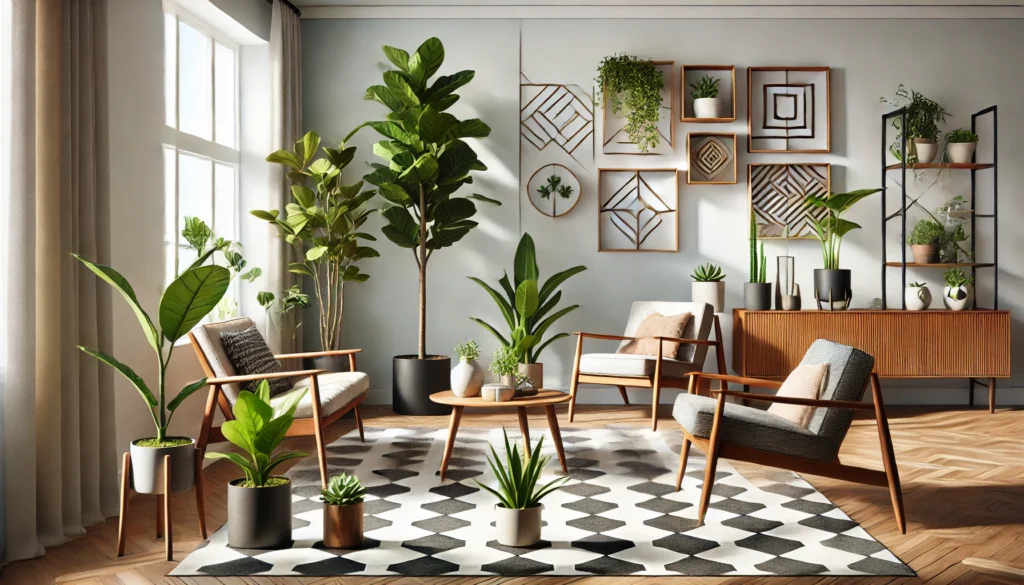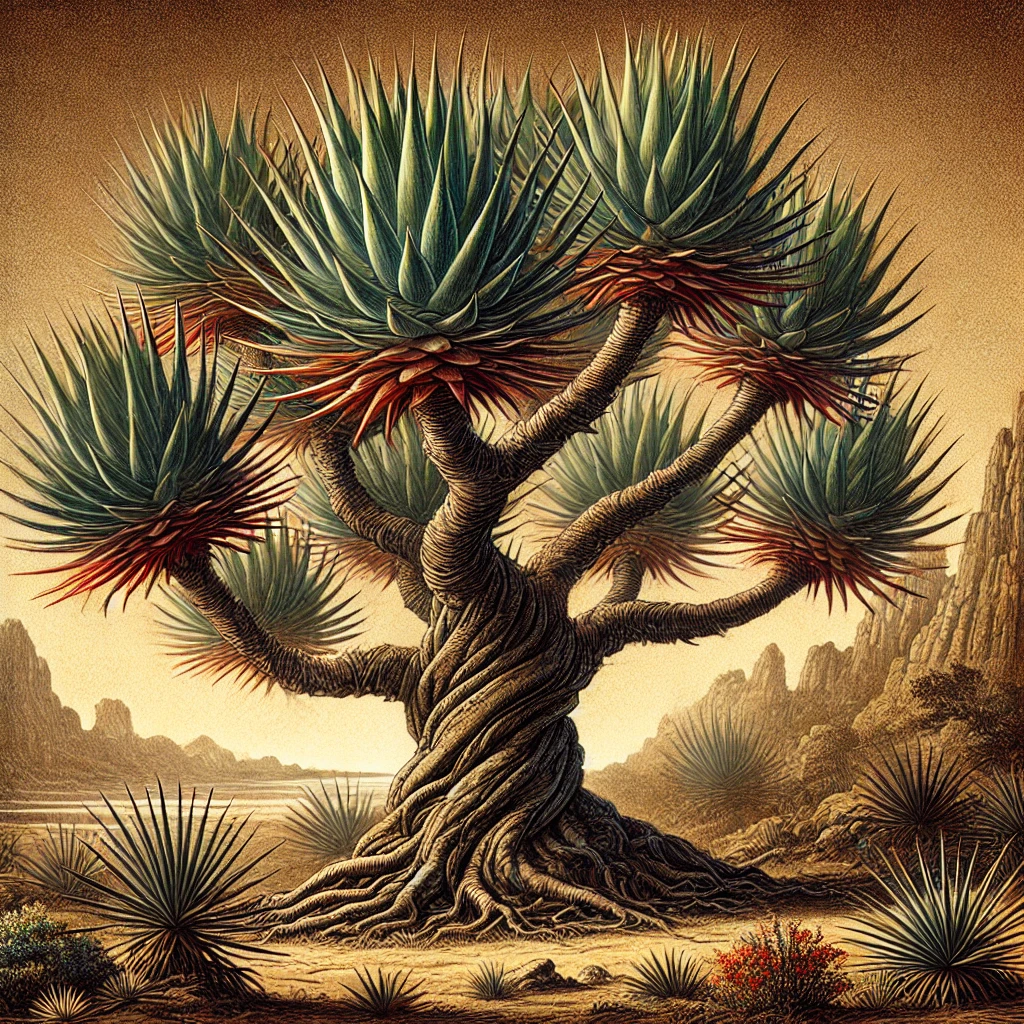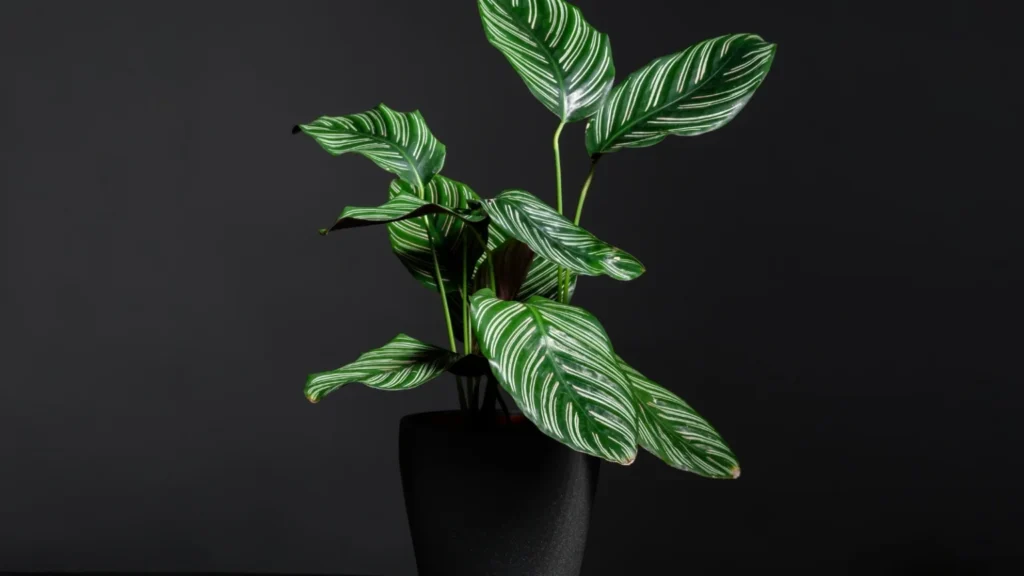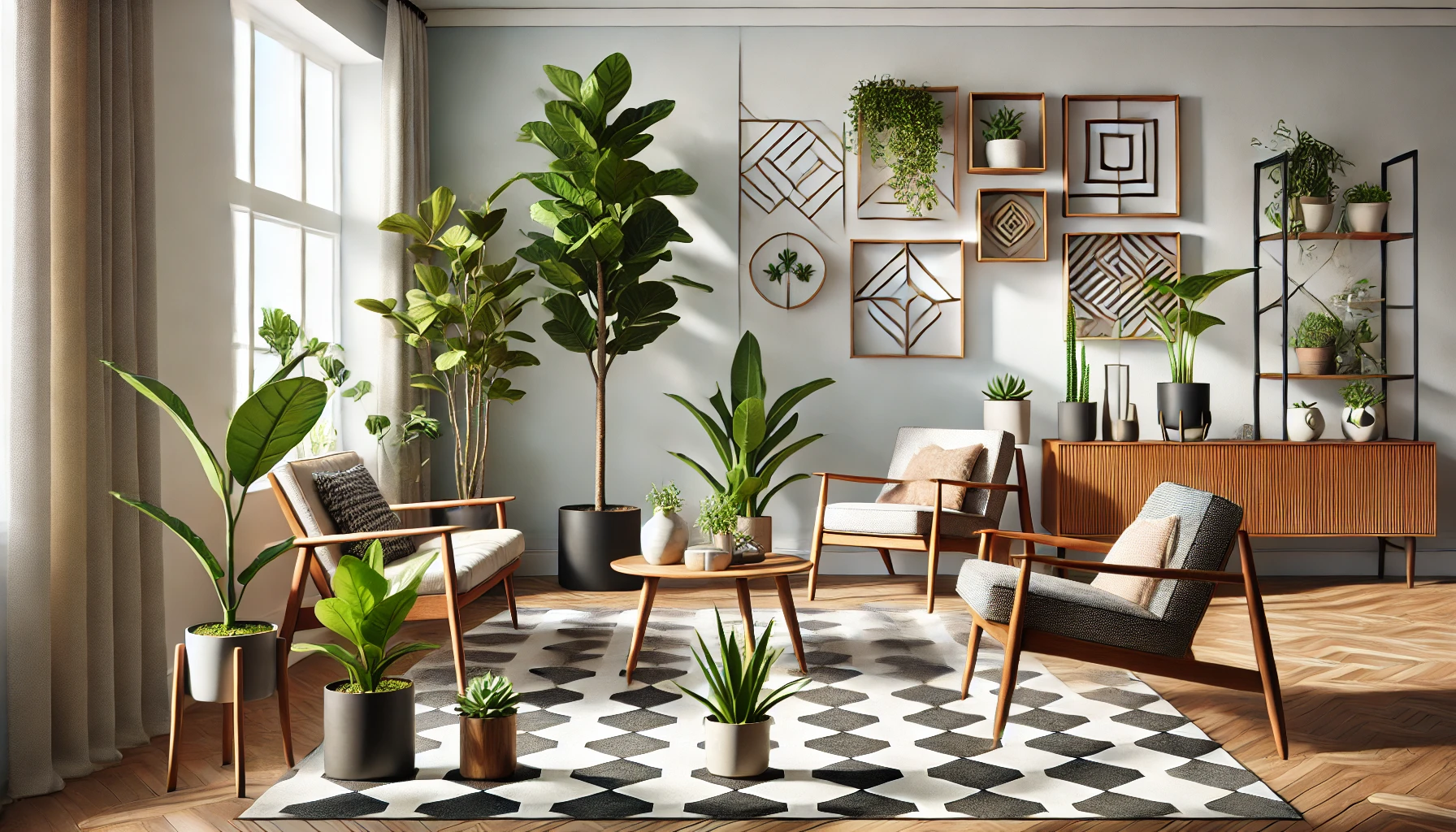Introduction
Houseplants for midcentury modern homes play a crucial role in enhancing the style’s signature aesthetic. These plants bring a natural, organic touch that contrasts beautifully with the clean lines and minimalist designs typical of midcentury modern interiors. Not only do they add vibrant colors and textures, but they also improve air quality and create a peaceful, welcoming atmosphere. Whether placed in simple, sculptural planters or tucked into functional spaces, houseplants seamlessly complement the sleek, timeless appeal of midcentury modern design.

Table of Contents
Snake Plant
One of the most versatile houseplants for midcentury modern interiors is the Snake Plant. Its upright, sword-like leaves offer a striking visual element that pairs beautifully with the simplicity of midcentury modern furniture. Available in various cultivars, such as the whale fin Snake Plant (Dracaena masoniana), this plant can grow up to five feet tall, making it perfect for spacious, bright rooms.
Caring for Snake Plants is straightforward, making them an excellent choice for beginners. These houseplants for midcentury modern settings thrive in bright, indirect light but can tolerate low light conditions, adding to their appeal. They require minimal watering, with the soil needing to dry out between waterings. For midcentury modern styling, consider planting Snake Plants in sleek ceramic or metal pots with clean lines that echo the era’s aesthetic.
Monstera
The Monstera, often called the “Swiss cheese plant,” is another iconic choice for midcentury modern homes. Its large, fenestrated leaves create a bold statement, adding an organic, sculptural quality to interiors. Monstera plants thrive in semi-moist soil and bright, indirect light, making them ideal for placing near large windows or in well-lit living spaces.
To care for your Monstera, water it when the top inch of soil feels dry, and provide support for its climbing habit using a moss pole or trellis. For a truly midcentury modern vibe, pair your Monstera with a planter that features wooden legs or geometric patterns, enhancing its visual appeal.
| Plant | Light | Water | Soil |
|---|---|---|---|
| Snake Plant | Bright, indirect or low | Allow soil to dry | Well-draining cactus mix |
| Monstera | Bright, indirect | Semi-moist, not soggy | Rich, well-draining potting soil |
Blushing Bromeliad
Blushing Bromeliads bring a pop of color and a tropical vibe to midcentury modern interiors. Their rosette-shaped foliage, often with a blush of red or pink, contrasts beautifully with the neutral tones of midcentury modern furniture. Neoregelia carolinae, a popular variety, is particularly well-suited for adding visual interest to side tables or shelves.
These houseplants for midcentury modern spaces prefer bright, indirect light and need their central cup filled with water. The soil should dry slightly between waterings, and a potting mix with good drainage, such as orchid bark mixed with perlite, is ideal. Use minimalist planters in metallic finishes or muted tones to highlight the plant’s vibrant colors without overwhelming the space.
ZZ Plant
The ZZ Plant, known for its glossy, dark green leaves, is a low-maintenance option that thrives in midcentury modern settings. Its ability to tolerate low light and infrequent watering makes it perfect for busy homeowners or less sunny spaces.
To care for a ZZ Plant, allow the soil to dry out completely between waterings, and place it in a spot with indirect sunlight. These houseplants for midcentury modern interiors look stunning in matte black or white planters, creating a chic, understated look that aligns with the design principles of the era.
Dragon Tree

Dragon Trees are prized for their spiky, architectural form, which adds a dynamic element to midcentury modern interiors. Their narrow, sword-like leaves often feature colorful margins, such as pink or red, that provide a subtle contrast to the neutral palette of midcentury modern homes.
These plants thrive in bright, indirect light and require consistent moisture during the growing season. In winter, reduce watering to prevent root rot. Pair a Dragon Tree with a tall, cylindrical planter in a neutral tone to emphasize its vertical growth habit and dramatic appearance.
Fiddle Leaf Fig
The Fiddle Leaf Fig is a quintessential houseplant for midcentury modern homes. Its large, violin-shaped leaves make a bold statement, filling empty corners or framing seating areas with lush greenery.
Fiddle Leaf Figs prefer bright, indirect light and consistent moisture, though their soil should never be soggy. To maintain their iconic shape, rotate the plant regularly for even growth and prune occasionally to encourage branching. Opt for a midcentury-style planter with wooden legs or a textured ceramic pot to complement its striking form.
Prayer Plant
Prayer Plants are unique houseplants for midcentury modern interiors, known for their folding leaves that “pray” at night. Their intricate patterns and rich colors, such as red veins and green foliage, add depth and texture to any room.
These plants thrive in humid conditions and require consistently moist soil. Place them in bathrooms or use a humidity tray to mimic their natural environment. For a cohesive look, use a low-profile planter in a pastel or neutral shade, aligning with midcentury modern aesthetics.
Pothos
Pothos plants are versatile and easy to care for, making them a popular choice for midcentury modern homes. Their trailing vines can be styled to drape elegantly from shelves or hang in decorative baskets, adding a touch of greenery to vertical spaces.
These houseplants for midcentury modern interiors thrive in low to bright indirect light and require infrequent watering, allowing the soil to dry between waterings. Use bold, geometric planters to enhance their cascading foliage and create a striking visual effect.
Pinstripe Calathea
Pinstripe Calatheas are perfect for brightening up midcentury modern spaces with their striking pink-striped leaves. Their dark green foliage with purple undersides provides a dramatic contrast that works well with minimalist decor.
These plants need high humidity and consistent moisture, making them ideal for bathrooms or areas with humidifiers. Choose sleek, modern planters in neutral tones to showcase their vibrant foliage without overwhelming the design.

FAQs about Houseplants for Midcentury Modern Homes
What are the best houseplants for midcentury modern homes? The best houseplants for midcentury modern homes are those that complement the clean, minimalist design and organic forms typical of the style. Popular options include the Snake Plant, Monstera, ZZ Plant, Fiddle Leaf Fig, Pothos, Blushing Bromeliad, and Dragon Tree. These plants not only add visual interest but also bring a touch of nature and vibrancy to the space, balancing the sleekness of midcentury modern furniture.
Why are houseplants important in midcentury modern interiors? Houseplants bring nature indoors and soften the geometric, minimalist features of midcentury modern design. They add color, texture, and organic shapes, creating a balance between the natural world and man-made elements. Additionally, plants improve air quality and create a more inviting, peaceful atmosphere, which enhances the overall livability and comfort of the home.
How do I care for a Snake Plant in a midcentury modern home? The Snake Plant is easy to care for and perfect for midcentury modern homes. It thrives in bright, indirect light but can also tolerate lower light levels. It requires minimal watering, with the soil needing to dry out completely between waterings. It prefers a well-draining cactus mix or a similar soil. Plant it in sleek, minimalist planters like ceramic or metal pots that align with the clean lines and simple aesthetics of midcentury modern style.
What makes the Monstera plant ideal for midcentury modern décor? The Monstera, often called the “Swiss cheese plant,” is perfect for midcentury modern homes because of its bold, sculptural leaves that introduce an organic, tropical feel to the space. Its large, fenestrated leaves create visual drama, making it an ideal statement plant. It pairs well with geometric planters, wooden-legged pots, or any containers that echo the midcentury modern style, adding to its aesthetic appeal.
Can the ZZ Plant survive in low light? Yes, the ZZ Plant is one of the best houseplants for low-light environments, making it ideal for spaces in midcentury modern homes that may not receive a lot of natural sunlight. The ZZ Plant is known for its glossy, dark green leaves and can tolerate neglect, only needing occasional watering when the soil has completely dried out. Its low maintenance and sleek appearance make it a great fit for minimalist interiors.
How do I care for a Fiddle Leaf Fig in my home? Fiddle Leaf Figs need bright, indirect light to thrive. They should be watered regularly, but it’s essential to let the soil dry slightly between waterings to prevent root rot. These plants also need consistent moisture but should never sit in standing water. Rotating the plant periodically will help it grow evenly, and pruning can encourage branching. Use midcentury-inspired planters such as those with wooden legs or textured ceramic to enhance its striking form.
Are Blushing Bromeliads suitable for a midcentury modern home? Yes, Blushing Bromeliads are a great choice for midcentury modern homes due to their unique rosette-shaped foliage and vibrant colors. Their red or pink hues contrast beautifully with the neutral color palette often found in midcentury modern interiors. They require bright, indirect light and need to have their central cup filled with water. The soil should dry out slightly between waterings, and an orchid bark mix or similar well-draining soil is ideal for these plants.
What is the best planter for a Dragon Tree in midcentury modern design? Dragon Trees are tall, architectural plants that thrive in bright, indirect light. They have narrow, spiky leaves with colorful margins, adding a dramatic vertical element to the room. For the best aesthetic, place a Dragon Tree in a tall, cylindrical planter with a neutral finish. Planters made from materials such as matte ceramics or wood complement the clean, simple lines of midcentury modern furniture, drawing attention to the plant’s form.
Do Monstera plants need direct sunlight? No, Monstera plants prefer bright, indirect light. Direct sunlight can scorch their leaves, leading to unsightly brown spots. They are adaptable and can tolerate lower light levels, but they perform best when given access to bright, filtered light. Place them near windows where sunlight is diffused, or in spaces with plenty of natural light.
What kind of humidity does a Prayer Plant need? Prayer Plants thrive in humid environments, making them ideal for bathrooms or areas with high humidity levels. To maintain their health, ensure they have consistently moist soil and place them in locations where the humidity is naturally higher. You can also use a humidity tray or a humidifier to create the right conditions. These plants’ intricate leaf patterns and unique folding leaves add texture to midcentury modern interiors.
How often should I water a Pothos plant? Pothos plants are incredibly low-maintenance. Water them when the top inch of the soil feels dry, and they can tolerate some neglect in between waterings. This makes them an excellent choice for busy homeowners. Their trailing vines can be styled to cascade from shelves or hang in decorative baskets, adding greenery and texture to vertical spaces, which works well in midcentury modern interiors.
Can I place my houseplants near a heater or air conditioner? It’s best to avoid placing houseplants directly near a heater or air conditioner, as the dry air produced by these appliances can stress the plants. Excessive heat or cold drafts can damage their leaves or stunt their growth. Instead, place them in spots where the temperature is consistent and avoid areas with extreme fluctuations in temperature.
What size pot is best for my Fiddle Leaf Fig? Fiddle Leaf Figs prefer a large pot to allow their roots to grow. Choose a pot that’s slightly larger than the root ball, and make sure it has good drainage to prevent root rot. As the plant grows, you may need to repot it every couple of years into a larger container to accommodate its expanding roots and maintain healthy growth.
Are Dragon Trees difficult to care for? Dragon Trees are relatively low-maintenance. They do well in bright, indirect light and require watering when the soil feels dry. During winter, reduce watering to prevent overwatering. These plants are resistant to drought, making them easier to care for than some other plants, and their spiky, vertical form adds architectural interest to midcentury modern spaces.
Can I use decorative baskets for my Pothos plant? Yes, Pothos plants thrive in decorative baskets, which enhance their cascading vines. The trailing nature of Pothos makes it perfect for vertical displays. You can also use hanging baskets to let the vines drape down elegantly, adding greenery to your living room or any other area of the home. Choose planters that complement midcentury modern design, such as geometric or simple-textured containers.
How do I propagate a Monstera plant? Monstera plants can be propagated by cutting a stem just below a node (the point where leaves and roots form) and placing it in water or soil. In water, roots will form within a few weeks, after which you can transplant the cutting into a pot. Propagating Monstera allows you to expand your collection of plants while maintaining a cohesive look in your home.
Do Snake Plants need special soil? Snake Plants prefer well-draining soil to prevent root rot. A cactus or succulent mix is ideal, as it allows water to pass through easily and prevents the soil from staying soggy. It’s also important to use a planter with drainage holes to ensure proper water flow and help the plant thrive in a midcentury modern home.
Are Prayer Plants pet-friendly? Yes, Prayer Plants are non-toxic to both cats and dogs, making them a safe choice for households with pets. Their rich green foliage and striking patterns can brighten up a room while ensuring the safety of your furry friends.
How do I prevent my Fiddle Leaf Fig from getting brown edges? Brown edges on Fiddle Leaf Fig leaves can be a sign of inconsistent watering or low humidity. To prevent this, water the plant consistently when the top layer of soil feels dry, and increase humidity by placing the plant on a humidity tray or near a humidifier. Ensure the plant is not in a drafty spot or near an air conditioning vent, as these can also cause stress to the plant.
Can I place my houseplants in a corner of my midcentury modern living room? Yes, houseplants like Snake Plants, Fiddle Leaf Figs, and Monstera plants thrive in corners, adding height and structure to otherwise empty spaces. Their organic forms complement the straight lines of midcentury modern furniture, while also contributing to a balanced, harmonious design.
Conclusion
Houseplants for midcentury modern interiors offer a perfect blend of form and function. From the bold foliage of the Fiddle Leaf Fig to the low-maintenance elegance of the ZZ Plant, these houseplants for midcentury modern homes enhance both the aesthetic appeal and livability of your space. By incorporating these carefully chosen houseplants, you can transform your midcentury modern home into a lush, inviting sanctuary that reflects timeless style and natural beauty. For more inspiration, explore houseplants perfect for a mid-century modern home. You can also check out tips on revealing the truths behind common garden myths, winter gardening to heal holiday grief, and how to identify plants with Google Lens.

